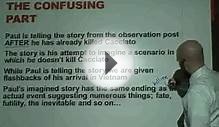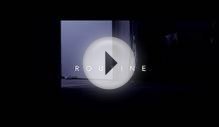
Narrative structure, a literary element, is generally described as the structural framework that underlies the order and manner in which a narrative is presented to a reader, listener, or viewer. The narrative text structures are the plot and the setting.
Generally, the narrative structure of any work—be it a film, play, or novel—contains a plot, theme, and resolution. It can also be divided into three sections, which are together referred to as the three-act structure: setup, conflict, and resolution.
The setup (act one) is where all of the main characters and their basic situations are introduced, and contains the primary level of characterization (exploring the character's backgrounds and personalities). A problem is also introduced, which is what drives the story forward.
The second act, the conflict, is the bulk of the story, and begins when the inciting incident (or catalyst) sets things into motion. This is the part of the story where the characters go through major changes in their lives as a result of what is happening; this can be referred to as the character arc, or character development.
The third act, or resolution, is when the problem in the story boils over, forcing the characters to confront it, allowing all the elements of the story to come together and inevitably leading to the ending.
An example is the 1973 film . The first act of the film is when the main characters are introduced and their lives are explored; Father Karras (Jason Miller) is introduced as a Catholic priest who is losing his faith. In act two, a girl named Regan (Linda Blair) becomes possessed by a demonic entity (the problem), and Karras' character arc is being forced to accept that there is no rational or scientific explanation for the phenomenon except that she actually is possessed by a demon, which ties in directly with the theme of him losing his faith. The third act of the film is the actual exorcism, which is what the entire story has been leading to.
Theorists describing a text's narrative structure might refer to structural elements such as an introduction, in which the story's founding characters and circumstances are described; a chorus, which uses the voice of an onlooker to describe the events or indicate the proper emotional response to be happy or sad to what has just happened; or a coda, which falls at the end of a narrative and makes concluding remarks. First described in ancient times by Greek philosophers (such as Aristotle and Plato), the notion of narrative structure saw renewed popularity as a critical concept in the mid-to-late-20th century, when structuralist literary theorists including Roland Barthes, Vladimir Propp, Joseph Campbell, and Northrop Frye attempted to argue that all human narratives have certain universal, deep structural elements in common. This argument fell out of fashion when advocates of poststructuralism such as Michel Foucault and Jacques Derrida asserted that such universally shared, deep structures were logically impossible.
In Frye's, he deals extensively with what he calls myths of Spring, Summer, Fall, and Winter:
Narrative structures[edit]
Most forms of narrative fall under four main categories; Linear narratives, nonlinear narrative, interactive narration, and interactive narrative.
- Linear narrative is the most common form of narration, where events are largely portrayed in a chronological order, i.e. telling the events in the order they occurred.
- Nonlinear narratives, disjointed narrative or disrupted narrative is a narrative technique, where events are portrayed, out of chronological order or in other ways where the narrative does not follow the direct causality pattern.
- Interactive narrative is a form of fiction in which users are able to make choices that influencing the narrative (e.g. through alternative plots or resulting in alternative endings) through their actions.
Linear narrative[edit]
Flashbacks are often confused with true narratives which are not linear, but the concept is fundamentally linear. Although some films appear to open (very briefly) with the ending, flashback movies almost immediately jump back to the very beginning of the story to proceed linearly from there, and usually proceed past the supposed "ending" shown at the beginning of the movie.
An even more ambitious attempt at constructing a film based on non-linear narrative is Alain Resnais's 1993 French film . The plot contains parallel developments, playing on the idea of what might have happened had the characters made different choices. But because the user experience is that of a spectator in a movie theatre, the public has no control of the direction of the narrative.
Nonlinear narrative[edit]
Cinema can only provide the illusion through broken narrative, a famous example of this being the 1994 film . The film is ostensibly three short stories, which, upon closer inspection, are actually three sections of one story with the chronology broken up; Quentin Tarantino constructs the narrative without resorting to classic "flashback" techniques.
Interactive narration[edit]
In works of Interactive narration there is only one narrative but the method of delivery requires the user to actively work to gain the next piece of the narrative, or have to piece the parts of narrative that they have together in order to form a coherent narrative.
This is the narrative approach of some modern video games. A player will be required to reach an objective, complete a task, solve a puzzle, or finish a level before the narrative continues.
Interactive narrative[edit]
An Interactive narrative is one which is composed with a branching structure where a single starting point may lead to multiple developments and outcomes. The principle of all such games is that, at each step of the narrative, the user makes choices that advance the story, leading to new series of choices. Authoring non-linear narrative or dialogue thus implies imagining an indefinite number of parallel stories.
In a gamebook, readers are told to turn to a certain page according to the choice they wish to make to continue the story. Typically, the choice will be an action rather than dialogue. For example, the hero hears a noise in another room and must decide to open the door and investigate, run away, or call for help. This kind of interactive experience of a story is possible with video games and books (where the reader is free to turn the pages) but less adapted to other forms of entertainment. Improvisational theatre is similarly open-ended, but of course cannot be said to be authored.
tools[edit]
The emergence of the video game industry—a marketplace that has overtaken film and television in global revenue —and the trend in marketing towards gamification as a major industrial activity would both indicate that non-linear narrative will be a staple of both entertainment and advertising in the coming decade.
Recently more tools for non-linear authoring have emerged, such as Adobe Captivate, a popular elearning authoring tool for presentations, quizzes, and simulations that enables authors of elearning to construct links between slides in a PowerPoint-style document to produce non-linear sequences. Zebra Zapps is a sophisticated elearning authoring system developed by Allen Interactions which has recently added the possibility of linking objects to construct a non-linear scene.
RELATED VIDEO











